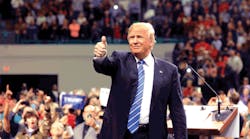The election of Donald Trump as U.S. President took many of us by surprise—and provided a shock to the markets as well as the pollsters. Throughout the campaign, the media focused far more on the personalities of the main contenders than on any serious analysis of policies, so little time was spent considering what a Trump victory might mean.
We now need to find a way forward in this new world that Americans have voted for, and to understand its impact on the supply chain serving our economy. While we are still a long way from having a clear picture of the new administration, we can draw some conclusions about what it may mean for supply network design, manufacturing strategy and resource planning, taking some of Trump's stated policies (shown in italics below) as a starting point.
Trade
"Withdraw from the Trans Pacific Partnership."
"Label China a currency manipulator."
"Renegotiate NAFTA."
Harsher even than Brexit, Trump's intent appears to involve entering into conflict with the United States' biggest trading partners. For hundreds of companies whose manufacturing and assembly is in either China or Mexico, this promises trouble. The cost of sourcing from these regions is likely to rise substantially, while finished goods and parts could be stranded overseas. At the same time, sales to these countries will slow or stop as trade negotiators jockey for position and barriers appear elsewhere. A move to protectionism will not take place unilaterally; we can expect to see tit-for-tat measures in response.
The result may well be more local- for-local manufacturing, but this does not necessarily mean more jobs in the U.S. Instead, we are likely to see more plants producing small lot sizes and using heavily automated production.
Network design going forward must account for high risks in globally sourced bills of materials. Global product platforms could help as R&D spending can be shared among a larger number of smaller plants closer to end markets.
Immigration
"Begin working on an impenetrable physical wall on the southern border."
"End sanctuary cities."
"All immigration laws will be enforced."
For industries with a dependence on low-cost, imported (and occasionally illegal) labor, including agriculture and food processing, this will raise costs. Downstream buyers, including consumer packaged goods, will need to pass along price increases initially and then work with suppliers to use automation in order to lower costs. This could dictate changes in favored crops and protein sources. Smaller boutique food companies may benefit as premium products are generally far less price-sensitive.
For industries such as high tech and pharmaceuticals, the new immigration policies could be beneficial, particularly if a fast-track immigration system is implemented for technical hires. In this case it may be worth considering the proactive recruitment of talented foreign-born production engineers with experience managing intense automation and/or data analytics.
Energy
"Become, and stay, totally independent of any need to import energy from the OPEC cartel."
"Rescind … all Obama executive actions."
As part of a wider "America first" philosophy, these policies promise less access to world energy markets, which will mean higher costs in the U.S. If global markets remain open, this could be good news for the rest of the world as the removal of U.S. demand would probably mean lower energy costs for everyone else. At the same time, a protectionist policy in U.S. energy could enhance the business case for renewables if oil is more expensive. It is also possible that logistics costs could go down as global shipping demand dwindles and fuel prices moderate or drop.
For supply network designers the implications include a stronger case for diversified energy sources. Production facilities and data centers should increasingly be designed with variable energy infrastructure in mind.
Taxes
"Lower the business tax rate from 35% to 15%."
Whether this, along with proposed personal tax cuts, can be paid for without sparking inflation is unknown, but the implications for supply chain strategy are significant.
U.S. taxes are currently among the highest in the world. Efforts to circumvent them have led to the separation of intellectual property from physical products and have left earnings stranded overseas. This change, if it takes place, could allow businesses to choose their location based on fitting customer markets and key personnel, rather than on tax optimization. The change could simplify network design for functions such as planning, sourcing and product development.
Where next?
The shape of the world is changing and globalization may be approaching its end. We can certainly expect a serious chill on global trade, which means that some great diplomacy will be required in order to avoid a trade war with giants such as China or even Europe.
Looking ahead, it seems that the supply chains of the future may be less dependent on distant, low-cost labor and resources and instead focused on local markets, both for sourcing and to find customers.
Kevin O'Marah is chief content officer with SCM World (www.scmworld.com), a cross-industry community of more than 100 global organizations. He holds specific responsibility for content relating to sales & operations planning, customer centricity and demand management, digital demand and omni-channel.



